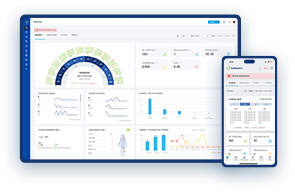
10 Key Elements of an Effective Incident Report
A robust incident reporting system is crucial for effective safety management. Good incident reports help identify hazards, prevent future incidents, and ensure compliance. They provide a clear and concise account of incidents, enabling timely investigations and corrective actions.
Including comprehensive details such as what happened, where it occurred, and who was involved is essential for understanding and addressing root causes. Timely and accurate reports facilitate immediate responses and long-term safety improvements. Ultimately, well-structured incident reports contribute to a safer workplace by promoting transparency, accountability, and continuous learning from past events.
Let’s explore the key elements that make an incident report effective and reliable.
1. Clear and Concise Reporting
Accurate and straightforward reporting is the cornerstone of an effective incident report. Start with a detailed description of the incident. Clearly explain what happened, where it happened, and who was involved. This sets the stage for understanding the event fully.
Clarity is key. Use simple, direct language that avoids jargon. The goal is to make the report understandable for anyone who reads it, regardless of their technical background.
Brevity is equally important. Keep the information concise, focusing on the essential details. Avoid unnecessary elaboration that can obscure the main points. A well-written, clear, and concise report ensures that critical information is communicated effectively, aiding in swift and accurate decision-making.
2. Timeliness
Prompt reporting is vital in incident management. The sooner an incident is reported, the quicker an investigation can commence. This immediacy helps in capturing accurate details and prevents the situation from worsening.
Including precise date and time stamps is crucial. This information helps in tracking the sequence of events and can be critical during an investigation. Timely reports also allow for immediate corrective actions, which can mitigate further risks and damages.
Encouraging a culture of prompt reporting within the organization ensures that incidents are not overlooked or forgotten. This proactive approach enhances overall safety and responsiveness.
3. Comprehensive Details
A good incident report provides a complete picture of the event. Start by classifying the incident type—whether it’s an accident, near-miss, or observation. This helps in understanding the nature and severity of the incident.
Detail the environmental conditions at the time. Factors like weather, lighting, and location can provide important context. Describe any injuries sustained and damages to property or equipment, as these are crucial for assessing the incident’s impact.
Comprehensive details enable a thorough investigation and help in identifying all contributing factors. This depth of information is essential for developing effective preventive measures.
4. Root Cause Analysis
Understanding the root cause of an incident is key to preventing its recurrence. Begin with any immediate observations that might indicate the cause. These initial insights can guide the direction of the investigation.
Summarize the findings from a detailed root cause analysis. Identifying underlying issues, rather than just surface problems, is crucial. This thorough approach ensures that corrective measures address the actual causes of the incident.
Root cause analysis is a critical component in learning from incidents and improving safety protocols. It transforms incidents into opportunities for systemic improvements.
5. Corrective and Preventive Actions (CAPA)
Documenting corrective and preventive actions is essential. Start with any immediate actions taken to mitigate the incident’s impact. These actions show the organization’s responsiveness.
Outline long-term solutions to prevent similar incidents in the future. This includes changes to processes, training, or equipment. Clearly assign responsibilities for implementing each action to ensure accountability.
CAPA not only addresses the current incident but also strengthens overall safety practices. Effective CAPA leads to a safer work environment by preventing the recurrence of similar incidents.
6. Witness Statements
Witness accounts provide additional perspectives on the incident. Include detailed statements from all witnesses to capture diverse viewpoints.
Ensure you gather contact information for witnesses. This allows for follow-up questions if further clarification is needed. Witness statements can offer crucial insights that might not be immediately apparent.
Including these accounts enriches the incident report and helps build a more complete understanding of the event. Witnesses can often provide details that fill in gaps or highlight overlooked aspects.
7. Supporting Evidence
Supporting evidence strengthens the incident report. Attach photographs, videos, and any other visual evidence that can provide a clearer understanding of the incident.
Include relevant documents and logs. These might be maintenance records, safety logs, or any other pertinent documentation. This evidence can substantiate the report and aid in the investigation.
Strong supporting evidence ensures the report is thorough and credible. It helps investigators and reviewers understand the incident more clearly and supports accurate conclusions.
8. Review and Approval
A structured review process ensures the report’s accuracy and completeness. Detail how the report will be reviewed and by whom. This step adds an essential layer of scrutiny.
Management sign-off is crucial. It shows that the report has been vetted at a high level and that appropriate oversight has been applied. This step also ensures that the necessary authority is aware of the incident.
The review and approval process adds credibility to the report. It ensures that all necessary information has been included and that the report is ready for use in safety improvements.
9. Follow-up Actions
Monitoring the implementation of corrective actions is essential. Detail how these actions will be tracked to ensure they are completed.
Explain how the effectiveness of these actions will be verified. This step ensures that the measures taken are actually preventing similar incidents from occurring.
Regular follow-up demonstrates a commitment to continuous improvement. It ensures that corrective actions are not just implemented but are also effective in enhancing safety.
10. Lessons Learned
Documenting lessons learned from incidents is invaluable. This process helps create a knowledge repository that can be used to improve future safety practices.
Discuss how these lessons will be shared with employees and integrated into training programs. Effective communication of lessons learned ensures that the entire organization benefits from the insights gained.
Learning from past incidents is a proactive approach to safety. It helps in preventing future incidents and fosters a culture of continuous improvement and learning.
Download free lessons learned report template.
Safetymint for Efficient Incident Reporting
Safetymint transforms the way organizations handle incident reporting, making it easier and more efficient than ever. With our cloud-based safety management software, you can streamline your entire safety process using intuitive web and mobile applications.
Safetymint enables anyone in your organization to report incidents, observations, and near-misses quickly and effectively. The user-friendly interface ensures that reports are clear and concise, while the integrated dashboard and statistics section provide powerful data analytics to help you track trends and make informed decisions.
Safetymint’s features include real-time notifications and alerts, ensuring prompt responses to reported incidents and assigned actions. Custom workflows and digital signatures facilitate seamless approvals, while our comprehensive 5-step incident investigation process, including Root Cause Analysis and Corrective and Preventive Actions (CAPA), ensures thorough and effective resolutions.
The system’s “Lessons Learned” feature creates a valuable knowledge repository, helping your team learn from past incidents and continuously improve safety practices. Whether deployed on the cloud or on-premise, Safetymint is customizable to meet your organization’s specific needs.
Try Safetymint today and empower your organization to create a safer, more compliant workplace.
Ben Johnson is a dedicated Customer Success Executive at Safetymint. With a strong commitment to excellence, Ben works closely with customers to ensure they fully leverage the capabilities of Safetymint to its fullest potential, aiming to significantly reduce or mitigate safety risks and incidents.




